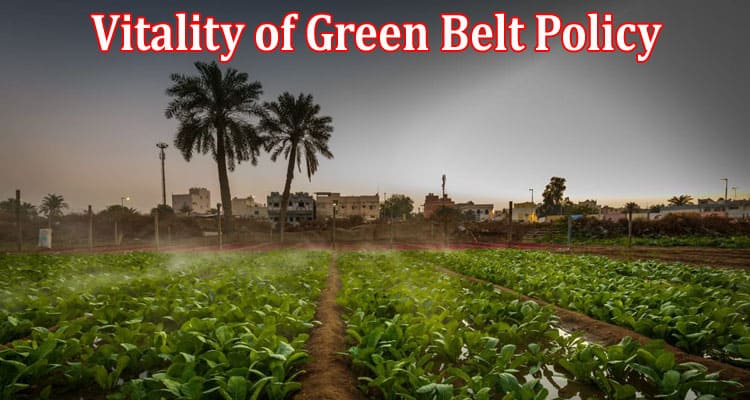Vitality of Green Belt Policy for Sustainable Cities
What is the Green Belt Policy?
The Green Belt Policy is an urban planning concept that involves designating and preserving open and undeveloped land around urban areas to prevent urban sprawl and promote sustainable development. It aims to create a buffer zone or belt of protected land that separates urban areas from surrounding countryside. The primary goal of the Green Belt Policy is to control urban expansion, protect natural landscapes, promote efficient land use, and maintain balance between development and environmental conversation. The policy imposes restrictions on the types and extent of development allowed within the designated Green Belt areas. These restrictions may include limits on residential, commercial, and industrial development to prevent urban encroachment into rural and natural spaces.
The Green belt policy, a stalwart of urban planning, has emerged as a critical tool in shaping sustainable cities that strike a harmonious code between human development and the preservation of natural landscapes. In an era marked by unprecedented urbanization and environmental challenges, this policy places up a hotel role in fostering balanced growth, conserving biodiversity, mitigating climate change, and enhancing the overall well-being of urban dwellers. In this article we will learn more about the Green Belt than how it will play a vital role for sustainable cities.
Cutting Urban Sprawl
The Green belt policy’s foremost vitality lies in its ability to curb urban sprawl, a phenomenon characterized by unchecked horizontal expansion of cities into surrounding rural areas. By designating specific zones where development is controlled or restricted, the policy serves as a buffer that prevents the unrestrained encroachment of concrete jungles onto valuable green spaces and agricultural lands. This containment not only preserves the aesthetic appeal of cities but also safeguards vital ecosystems, native flora, and fauna, contributing to the preservation of biodiversity.
Green belt areas, with their abundant vegetation, at the national carbon sinks, sequestering carbon dioxide from the atmosphere and contributing to climate change mitigation. The policy’s emphasis on preserving forests, wetlands, and open spaces helps in maintaining ecological balance and mitigating the impacts of urbanization-induced climate change, such as rising temperatures, heat islands, and erratic weather patterns.
Fostering Sustainable Transportation Networks: Paving the Way for Greener Commutes
A core tenet of the green belt policy is a promotion of compact urban forms, which in turn spurs that development of sustainable transportation networks. By restricting sprawl, the policy encourages the implementation of efficient public transportation systems, cycling lanes, and pedestrian friendly infrastructure. This not only reduces reliance on private vehicles, thereby curbing traffic congestion and improving air quality, but also fosters healthier lifestyles and enhanced mobility for urban residents.
Learn more about Green Belt Policy is a central feature for safeguarding fertile agricultural land from urban encroachment; the policy contributes to local food production, reducing dependence on distant sources. This safeguarding of agriculture resources bolsters food security and enhances the resilience of urban populations against supply disruptions.
Sustaining Ecosystem Services: Nature’s Contribution to Urban Well-being
Green belt areas provide a myriad of ecosystem services, ranging from ear and water purification to flood regulation and recreational spaces. These services not only enhance the overall quality of life for city dwellers but also yield economic benefits by reducing infrastructure costs, healthcare expenditures, and disaster recovery expenses. The policy’s emphasis on preserving and enhancing these services underscores the symbiotic relationship between thriving ecosystems and urban prosperity.
The Green Belt Policy acts as a guardian of a city’s aesthetic appeal and cultural heritage. By protecting iconic landscapes, historic sites, and distinctive topographies, the policy preserves the unique Identity and character of cities. To learn more about Green Belt Policy not only enriches the cultural fabric of the urban environment but also enhances their attractiveness as tourist destinations, contributing to sustainable tourism practices and economic growth.
Fostering Innovation and Creativity
While cities may argue that the Green Belt Policy hampers economic growth and exacerbates housing shortages, it also serves as a catalyst for innovation and creative urban planning solutions. These approaches stimulate economic vibrancy and rejuvenate neglected urban areas, promoting a more efficient utilization of limited land resources.
Conclusion
The vitality of the Green Belt Policy for sustainable cities is undeniable. From this article we will learn more about Green Belt Policy, which is multifaceted contributions, extending beyond physical boundaries, encompassing environmental preservation, climate change mitigation, sustainable transportation, agricultural resilience, community well being, and cultural preservation. In a rapidly evolving urban landscape, the policy’s role in harmonizing human progress with ecological integrity remains Paramount. As a city in navigating the complexity of the 21st century, the Green Belt policy stands as a testament to the imperative of forging a sustainable and resilient urban future.




